Fluid dynamics
So far we have studied fluids at rest now we will discuss fluid in motion. The study of fluids in motion is known as fluid dynamics. When a water-tap is turned on slowly, the water flow is smooth initially but loses its smoothness when the speed of the outflow is increased. In studying the motion of fluids we focus our attention on what is happening to various fluid particles at a particular point in space at a particular time.
Streamline flow or steady flow
Some streamlines for fluid flow
- The flow of a fluid is said to be steady if at any point, the velocity of each passing fluid particle remains constant within that interval of time.
- Streamline is the path followed by the fluid particle.
- It means that at any particular instant the velocities of all the particles at any point are the same. But the velocity of all the particles won’t be the same across all the points in space.
- Steady flow is termed as ‘Streamline flow’ and ‘Laminar flow’.
- No two streamlines can intersect.
- If two streamlines intersect each other, the particles won’t know which path to follow and what velocity to attain. That is why no two streamlines intersect.
To understand it more clearly let us try to understand this with the help of the example.
- Consider a case when all the particles of fluid passing point A have the same velocity. This means that the first particle will have velocity V1 and second will have velocity V1 and so on. All the particles will have the same velocity V1 at point A.
- At point B, all particles will have velocity V2. Similarly, at point C the velocity of all the particles is V3.
We can see that the velocity is changing from point to point but at one particular point, it is the same.
Equation of Continuity
According to the equation of continuity
Where A =cross-sectional area and V=velocity with which the fluid flows.
It means that if any liquid is flowing in streamlined flow in a pipe of non-uniform cross-section area, the rate of flow of liquid across any cross-section remains constant.
Consider a fluid flowing through a tube of varying thickness.
Let the cross-sectional area at one end (I) = A1 and the cross-sectional area of the other end (II) = A2.
The velocity and density of the fluid at one end (I) =v1, ρ1respectively, velocity and density of fluid at other end.
Volume covered by the fluid in a small interval of time Δt across left cross-section
Volume covered by the fluid in the same time across the right section=
Mass of fluid passes from the left end in time Δt=
Mass of fluid passes from the right end in time Δt =
If the fluid inside is incompressible which means volume doesn’t change with time and density remains the same then we have
This is called the equation of continuity.
This equation is termed as the conservation of mass of incompressible fluid.
Turbulent flow
Turbulent flow, a type of fluid (gas or liquid) flow in which the fluid undergoes irregular fluctuations, or mixing, in contrast to laminar flow, in which the fluid moves in smooth paths or layers. In turbulent flow, the speed of the fluid at a point is continuously undergoing changes in both magnitude and direction
This means fluid particles are moving here and there, they are not moving in an organized manner. They all will have different velocities. All the particles are moving here and there randomly.
Bernoulli’s equation
Fluid flow is a complex phenomenon. But we can obtain some useful properties for steady or streamlined flows using the conservation of energy.
Consider a fluid moving in a pipe of varying cross-sectional area. Let the pipe be at varying heights as shown in the figure. We now suppose that an incompressible fluid is flowing through the pipe in a steady flow
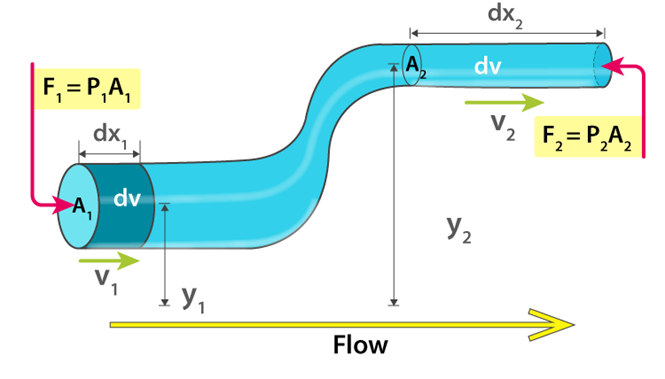
Its velocity must change as a consequence of the equation of continuity. A force is required to produce this acceleration. Which is caused by the fluid surrounding it, the pressure must be different in different regions.
The statement of Bernoulli’s principle
For a streamlined fluid flow, the sum of the pressure (P), the kinetic energy per unit volume
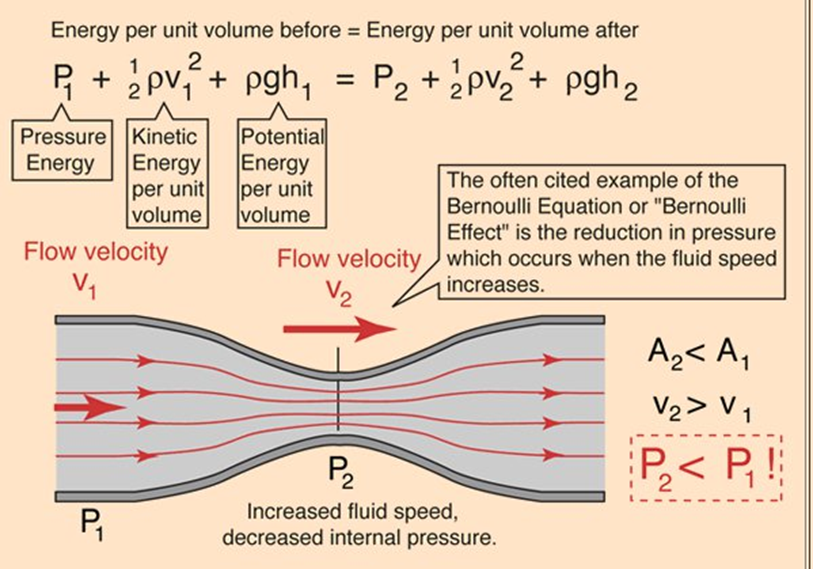
Assumptions in Bernoulli’s equation:
- Fluid flows through a pipe of varying width.
- Pipe is located at changing heights.
- Fluid is incompressible.
- Flow is laminar.
- No energy is lost due to friction: applicable only to non-viscous fluids.
When a fluid is at rest i.e. its velocity is zero everywhere, Bernoulli’s equation becomes P1 + ρgh1 = P2 + ρgh2; (P1 − P2) = ρg (h2 − h1)
Speed of Efflux - Torricelli's law
The word efflux means flow outward. Torricelli discovered that the speed of efflux from an open tank is given by a formula identical to that of a freely falling body.
Consider a tank containing a liquid of density ρ with a small hole in its side at a height y1 from the bottom (see figure given below). The air above the liquid, whose surface is at height y2, is at pressure P. From the equation of continuity, we have
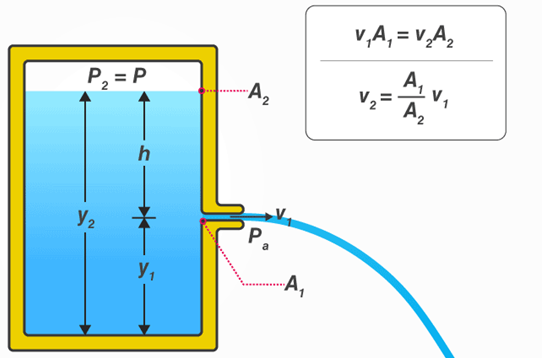
If the cross-sectional area of tank A2 is much larger than that of the hole (A2 >>A1), then we may take the fluid to be approximately at rest at the top, i.e. v2 = 0. Now applying the Bernoulli equation at points 1 and 2 and noting that at the whole P1 = Pa, the atmospheric pressure.
From Bernoulli’s equation we have ![]()
Simplifying we get ![]()
![]()
By taking
So finally we have ![]()
Since P1=Pa and P2=P
Then,![]()
Case 1: When the tank is open from the top P = Pa, then ![]()
This is the speed of a freely falling body. And the above equation is known as Torricelli’s law
Case 2: When the Tank is not open to the atmosphere but P>>Pa.
Therefore 2gh is ignored as it is very large, hence v1= √2P/ρ.
The velocity with which the fluid will come out of the container is determined by the pressure at the free surface of the fluid alone.
Venturimeter
Venturimeter is a device to measure the flow of incompressible liquid.
It consists of a tube with a broad diameter having a larger cross-sectional area but there is a small constriction in the middle.
It is attached to a U-tube manometer. One end of the manometer is connected to the constriction and the other end is connected to the broader end of the Venturimeter.
The U-tube is filled with a fluid whose density is ρ.
A1= cross-sectional area at the broader end, v1 = velocity of the fluid.
A2=cross-sectional area at the constriction, v2= velocity of the fluid.
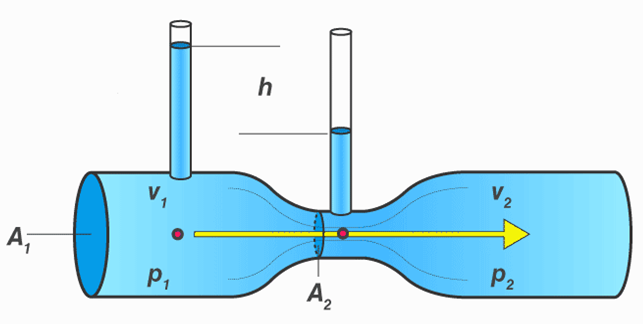
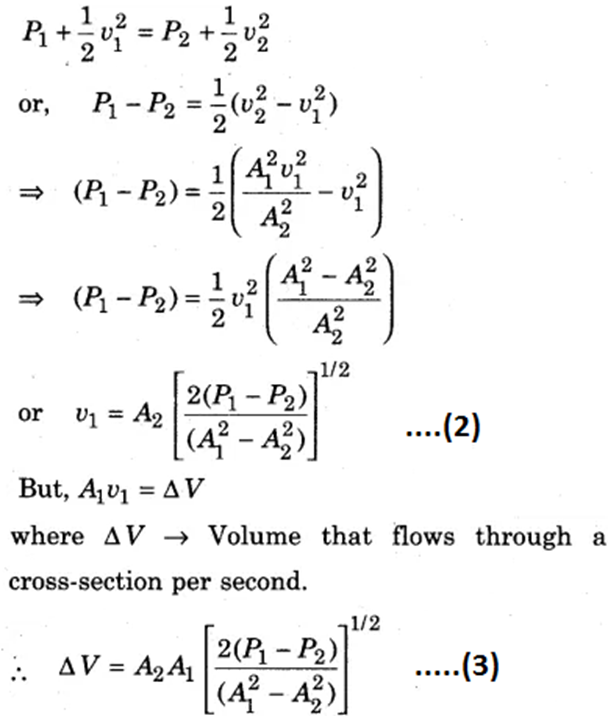
The principle behind this meter has many applications. Filter pumps or aspirators, Bunsen burners, atomizers and sprayers used for perfumes or to spray insecticides work on the same principle.
Blood flow and heart attack
Bernoulli’s principle helps in explaining blood flow in arteries.
- When the artery gets constricted due to the accumulation of plaque on its inner walls. In order to drive the blood through this constriction, a greater demand is placed on the activity of the heart.
- The speed of the flow of the blood in this region is raised which lowers the pressure inside and the artery may collapse due to the external pressure.
- As the blood rushes through the opening, the internal pressure once again drops due to the same reasons leading to a repeat collapse. This may result in a heart attack.
Dynamics lift
Dynamic lift is the force that acts on a body, such as an airplane wing, a hydrofoil or a spinning ball, by virtue of its motion through a fluid. In many games such as cricket, tennis, baseball, or golf, we notice that a spinning ball deviates from its parabolic trajectory as it moves through air.
Dynamic lift on airplane wings:-
Dynamic lift is most popularly observed in airplanes.
Whenever an airplane is flying in the air, due to its motion through the fluid here fluid is air in the atmosphere. Due to its motion through this fluid, there is a normal force that acts on the body in the vertically upward direction. This force is known as Dynamic lift.
Consider an airplane whose body is streamlined. Below the wings of the airplane, there is air that exerts an upward force on the wings. As a result, airplane experiences a dynamic lift.

Magnus Effect
Dynamic lift by virtue of spinning is known as the Magnus effect.
Magnus effect is a special name given to dynamic lift by virtue of spinning. Example:-Spinning of a ball.
Case1:-When the ball is not spinning.
- The ball moves in the air, it does not spin, the velocity of the ball above and below the ball is the same.
- As a result there is no pressure difference. (ΔP= 0). Therefore there is no dynamic lift.

Case2:- When the ball is moving in the air as well as spinning.
- When the ball spins it drags the air above it therefore the velocity above the ball is more as compared to the velocity below the ball.
- As a result, there is a pressure difference; the pressure is more below the ball. Because of the pressure difference, there is an upward force which is the dynamic lift.
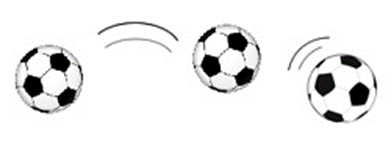
Viscosity
Most of the fluids are not ideal ones and offer some resistance to motion. This resistance to fluid motion is like internal friction analogous to friction when a solid moves on a surface. It is called viscosity. This force exists when there is relative motion between layers of the liquid.
Suppose we consider a fluid like oil enclosed between two glass plates as shown. The bottom plate is fixed while the top plate is moved with a constant velocity v relative to the fixed plate. If oil is replaced by honey, a greater force is required to move the plate with the same velocity. Hence we say that honey is more viscous than oil.
Stoke’s law
The force that retards a sphere moving through a viscous fluid is direct ∝ to the velocity and the radius of the sphere, and the viscosity of the fluid.
Mathematically: - F =6πηrv where
Let retarding force F ∝ v where v =velocity of the sphere
F ∝ r where r=radius of the sphere
F ∝ η where η=coefficient of viscosity and 6π = constant
Stokes law is applicable only to the laminar flow of liquids. It is not applicable to turbulent law.
Example: - Falling raindrops
Consider a single raindrop, when the raindrop is falling it is passing through air. The air has some viscosity; there will be some force that will try to stop the motion of the raindrop.
Initially, the raindrop accelerates but after some time it falls with constant velocity.
As the velocity increases the retarding force also increases. There will be vicious force Fv and bind force Fb acting in the upward direction. There will also be Fg gravitational force acting downwards.
After some time Fg = Fr (Fv+Fb)
Net Force is 0. If force is zero as a result acceleration also becomes zero.
Terminal Velocity
Terminal velocity is the maximum velocity of a body moving through a viscous fluid.
It is attained when the force of resistance of the medium is equal and opposite to the force of gravity.
As the velocity is increasing the retarding force will also increase and a stage will come when the force of gravity becomes equal to the resistance force.
After that point velocity won’t increase and this velocity is known as terminal velocity. It is denoted by ‘vt’.Where t=terminal.
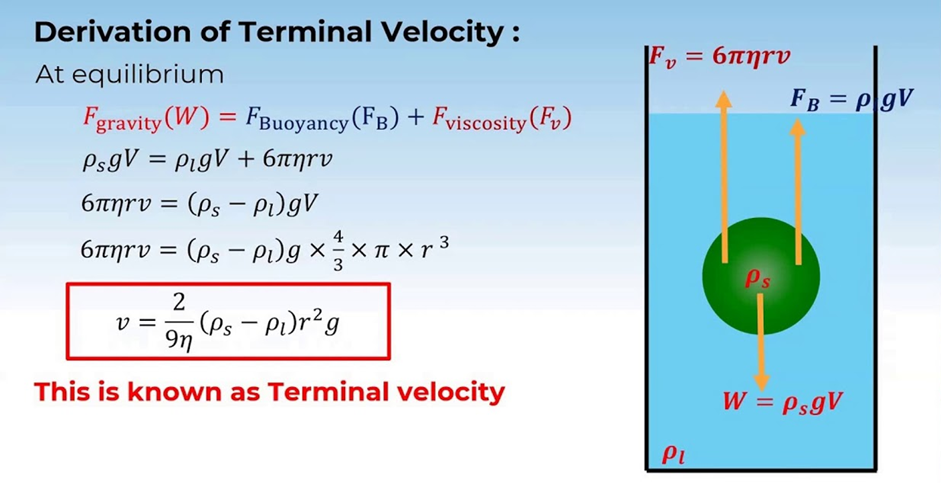

 Madhava Publications
Madhava Publications
